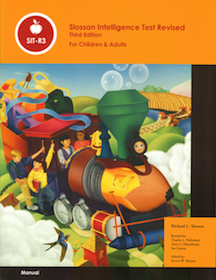Quantity Instructor Discount Available for the SIT-R3.....Refer to Promos Page
The SIT-R3 Complete Kit includes:
• Manual
• Technical Manual
with Calibrated Norms Tables
• Scannable Score Sheets (Pad of 50)
• Supplementary Manual
(For use with the Blind/Visually Impaired)
TThe Slosson Intelligence Test-R3 provides a quick, reliable index of
intellectual ability in children and adults, including those who are visually impaired or blind. Widely used in schools, clinics, and industry, the SIT-R3 has been designed to be used by a vast variety of educational administrators. Administrators specifically considered in this revision include teachers, principals, guidance counselors, special education and learning disability teachers, psychologists, psychometrics, and social workers who often need to evaluate an individual's mental ability.
It has been constructed so that the administration and scoring of the test occur simultaneously, thus enabling the test to be given in a brief period of time. Although the S'IT-R3 can not be administered to groups, individual administration overcomes shortcomings of other group tests. The SIT R3 does not penalize individuals who are extra careful, methodical, fearful and easily upset under the pressure of speed, poorly motivated, uncooperative, misunderstanding the importance of the task at hand, or have reading handicaps.
Six Verbal Cognitive Domains Tested in the SlT-R3 include:
I. General Information (GI)- reflects the learning of cultural knowledge, much of which is not explicity or directly taught.
2. Comprehension (CO) - reflects one's knowledge of social behavior, "common sense" and ability to interpret sayings and proverbs.
3. Quantitative ( QN)- reflects the ability to do mental calculations, remember the essential numbers, determine the arithmetic process required to calculate the correct answers.
4. Similarities and Differences (SD)- reflects one's skill in determining common attributes of two dissimilar things or concepts and some uncommon attributes.
S. Vocabulary (VO) - reflects the ability to use, understand and define words orally. Communication skills are dependent on vocabulary ability .
6. Auditory Memory (AM) - reflect's one's ability to remember and repeat correctly a random series of digits, both forward and backward, as well as several sentences.
After administering the SIT-R3, Comparisons can then be made with other tests yielding category standard scores on the verbal side.
Based on a sample of approximately 2,000 individuals, norms are presented in intervals of three months for ages 4.0 through 17 .11 years, with one normative group for ages 18 years and above. The SIT-R3 overall score is reported as a Total Standard Score (TSS) with a mean of 100 and a standard deviation of 16. Percentile ranks, mean age equivalents, T-scores, Normal Curve Equivalents (NCEs), and stanines are also provided.
Improved Areas of the SIT-R3:
• Even item distribution throughout the six verbal cognitive domains
• Test Items are free of demographic use Contemporary Language
• Larger Standardization Sample
• More Comprehensive Validity and Reliability Studies
• The Deviational Intelligence Quotient is extended to a Total Standard Score (TSS)
(SIT-R3) Slosson Intelligence Test - Revised
Third Edition
Ages: 4 through 65 years
Individual Administration: 10-20 minutes
Richard L. Slosson
Revise.d by: Charles L. Nicholson, PhD I Terry L. Hibpshman, PhD
Visual Impaired Supplmentary Manual: Sue Larson, PhD



